Scottish Sea Fisheries Statistics 2015
Details of landings of sea fish, the Scottish fishing fleet and the number of sea fishermen employed.
This document is part of a collection
1. Overview of landings
This chapter brings together information on the quantity, value, species and area of capture of sea fish landings. The focus is on Scottish registered vessels and landings into Scotland.
1.1 Landings by Scottish registered vessels
In 2015, Scottish registered vessels landed 440 thousand tonnes of sea fish and shellfish into the UK and abroad with a value of £437 million ( Table 1.1.e and Chart 1.1.). This represents an eight per cent decrease in quantity and a 15 per cent decrease in value in real terms compared to 2014.
Chart 1.1 Quantity and value of all landings by Scottish vessels: 2011 to 2015
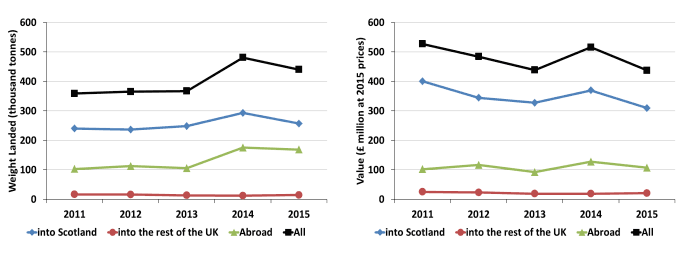
Landings by Scottish vessels accounted for 56 per cent of the value and 62 per cent of the quantity of all landings by UK vessels ( Tables 1.1.e, 1.1.o and 1.1.v). Since 2014, these figures have decreased by three and one percentage points respectively.
1.1.1 Demersal, pelagic and shellfish landings by Scottish registered vessels
In 2015, 292 thousand tonnes of pelagic fish species worth £160 million were landed by Scottish vessels. This accounted for 66 per cent of all landings by Scottish vessels in terms of quantity and 37 per cent in terms of value. Demersal species represented 21 per cent of the quantity of all landings (91 thousand tonnes) and 33 per cent of the value (£143 million), while shellfish landings accounted for 13 per cent of landings by quantity (58 thousand tonnes) and 31 per cent by value (£134 million) (Chart 1.2).
Chart 1.2 Quantity and value of landings by Scottish vessels; percentage of each species type, 2015
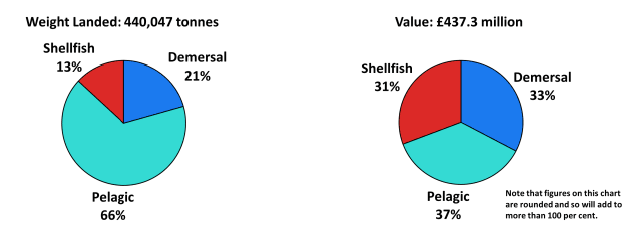
The 15 per cent decrease in the value of landings by Scottish registered vessels between 2014 and 2015 was driven by the decrease in value of pelagic species, although the other two species types also had a decrease in value (Chart 1.3). In real terms the value of pelagic landings decreased by 27 per cent from 2014 and shellfish and demersal landings decreased by 11 per cent and one per cent respectively. In real terms the total decrease in value from 2014 was £78 million.
The decrease in value of mackerel landings account for most of the decrease in the value of pelagic fish landings. Mackerel is the most valuable species to the Scottish fishing industry, accounting for 30 per cent of the total value of Scottish landings in 2015 and 81 per cent of the value of pelagic landings. The value of mackerel in real terms fell 33 per cent from 2014 due to the quantity landed decreasing by 17 per cent and the average price of mackerel decreasing by 20 per cent, from £816 per tonne in 2014 to £653 per tonne in 2015.
Herring, which accounts for five per cent of the total value of Scottish landings and 13 per cent of the total pelagic landings in 2015, increased in value in real terms by 15 per cent, even though the quantity landed decreased by four per cent since 2014. This is due to the price per tonne of herring increasing by 20 per cent, from £302 per tonne to £363 per tonne.
In 2015, the value of shellfish species decreased in real terms by 11 per cent (£16.9 million), mainly due to the quantity of shellfish landed decreasing by six per cent since 2014. Nephrops are the most valuable shellfish stock to the Scottish fishing industry, representing 14 per cent of the total value of Scottish landings in 2015 and 45 per cent of the value of shellfish landings. Both the value in real terms and quantity landed of Nephrops decreased by 19 per cent from 2014, while the price per tonne increased by one per cent, from £3,670 per tonne to £3,696 per tonne.
The value of demersal species decreased in real terms by one per cent (£0.8 million) since 2014. The value of monkfish, which represents six per cent of the total value of Scottish landings in 2015 and 18 per cent of the value of demersal landings, increased in real terms by five per cent, while the price per tonne decreased by 17 per cent, from £2,840 per tonne to £2,360 per tonne. The increase in value is due to the quantity landed increasing by 27 per cent. Haddock which represents nine per cent of the total value of Scottish landings in 2015 and 26 per cent of the value of demersal landings, decreased in real terms by 11 per cent. The decrease in value occurred because of a ten per cent decrease in quantity landed and a two per cent decrease in the price per tonne, from £1,386 per tonne to £1,362 per tonne.
Chart 1.3 Quantity and value of landings by Scottish vessels by each species type; 2011 to 2015
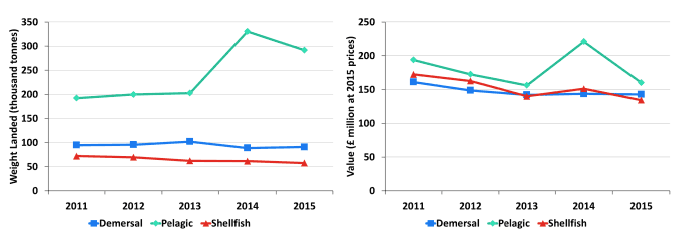
Chart 1.4 Percentage change from 2014 to 2015 in the real term price per tonne obtained for key fish species
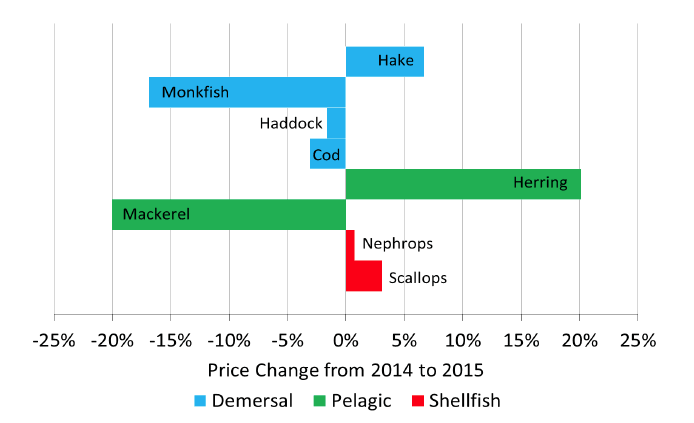
Prices of fish in 2015 and other years in real terms can be found in Table 1.1.x.
A breakdown of landings by Scottish vessels into Scotland, the rest of the UK and abroad, by species are given in Tables 1.1.a to 1.1.e. Corresponding figures for other UK vessels are presented in Tables 1.1.f to 1.1.o, and figures for foreign vessels landings into the UK in Tables 1.1.p to 1.1.t.
Demersal fish
Demersal species contributed 33 per cent of the overall value of landings by Scottish vessels in 2015. The total quantity of demersal species landed by Scottish vessels increased by two per cent from 2014. Demersal species contributed 21 per cent of the total quantity landed by Scottish vessels. Haddock accounts for 30 per cent, cod 13 per cent, monkfish 12 per cent and saithe and whiting both nine per cent of all demersal species landed by Scottish vessels in 2015.
Haddock, monkfish and cod are the three main demersal fish species landed by Scottish vessels in terms of value, accounting for 26 per cent, 18 per cent and 16 per cent respectively of all the demersal species landed in 2015. The value of demersal species decreased by one per cent in real terms from 2014 despite the increase of two per cent in the quantity landed. This was driven by decreases in value of various species including megrims, whiting, haddock and saithe which fell 16 per cent to £4.7 million, 12 per cent to £8.6 million, 11 per cent to £37.4 million and four per cent to £7.2 million, respectively. The effect of the reductions in the value for these species on the overall demersal sector value was buffered by the increase in value of other demersal species, namely hake, monkfish and cod which increased by 15 per cent, five per cent and two per cent respectively (Chart 1.5.a).
The increase in value in real terms for hake was due to a seven per cent increase in price per tonne from £2,239 per tonne to £2,389 per tonne and an eight per cent increase in the quantity of hake landed in 2015. Cod increased in value in real terms even though there was a three per cent decrease in the average price from £2,032 per tonne to £1,969 per tonne. This increase in value was due to a five per cent increase in quantity landed to 11.5 thousand tonnes.
From the real term prices per tonne ( Table 1.1.x and Chart 1.4), hake, ling and plaice were the only species that showed an increase in price from 2014.
Chart 1.5.a Quantity and value of landings of the key demersal species by Scottish vessels: 2011 to 2015
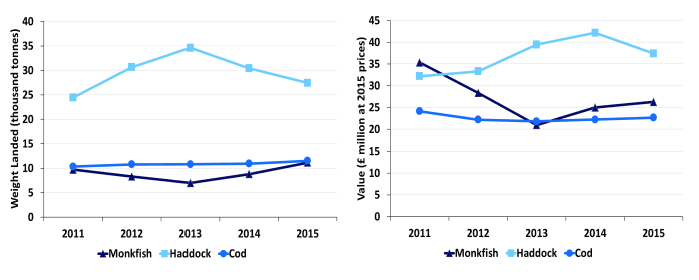
Pelagic fish
Mackerel and herring are the two main pelagic fish landed by Scottish vessels both in terms of quantity and value. In 2015 the total quantity of pelagic species landed by Scottish vessels decreased by 12 per cent from 2014 and the value decreased in real terms by 27 per cent. Mackerel, the stock with the largest landings by the Scottish fishing fleet, accounted for 81 per cent of the value and 69 per cent of the quantity of all the pelagic landings by Scottish vessels. Herring accounted for 13 per cent of the value and 20 per cent of the quantity of all the pelagic landings by Scottish vessels in 2015.
From 2014 to 2015, the value of mackerel decreased by 33 per cent in real terms and the quantity of landings decreased by 17 per cent (Chart 1.5.b). The price per tonne for mackerel also decreased 20 per cent (Chart 1.4), down from £816 per tonne to £653 per tonne. The value in real terms of herring increased by 15 per cent to £21.3 million, even though the quantity of landings decreased four per cent to 58.7 thousand tonnes. This change in value was largely due to the 20 per cent increase in price per tonne for herring, from £302 per tonne to £363 per tonne.
Blue whiting shows the largest increase in quantity landed and value in real terms between 2014 and 2015. The quantity landed rose 19 per cent to 30.5 thousand tonnes due to an increase in UK quota for blue whiting in 2015. This lead to a 65 per cent increase in the value in real terms to £6.3 million.
Chart 1.5.b Quantity and value of landings of the key pelagic species by Scottish vessels: 2011 to 2015
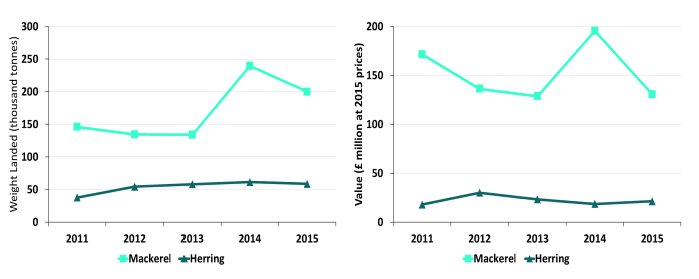
Shellfish
Nephrops and scallops are the two main species of shellfish landed by Scottish vessels. In 2015 the total quantity of shellfish species landed by Scottish vessels decreased by six per cent from 2014 and the value decreased in real terms by 11 per cent. Nephrops accounted for 45 per cent of the value and 29 per cent of the quantity of shellfish landed by Scottish vessels in 2015. Scallop landings accounted for 25 per cent of the value and 28 per cent of the quantity of all shellfish landings by Scottish vessels.
Nephrops are the most valuable shellfish species to the Scottish fishing industry, worth £61 million in 2015 and accounting for 14 per cent of the total value of all Scottish landings. The value of Nephrops landings by Scottish vessels decreased by 19 per cent in real terms from 2014. This decrease in value resulted from a 19 per cent decrease in the quantity landed to 16.5 thousand tonnes. The price per tonne for Nephrops increased by one per cent, from £3,670 per tonne to £3,696 per tonne.
In 2015, the value of scallops increased by one per cent, in real terms, from 2014 to £33.1 million. This increase in value occurred despite a two per cent fall in the quantity of scallop landings to 16 thousand tonnes. The decrease in quantity was offset by a three per cent increase in the price per tonne, from £2,001 per tonne to £2,062 per tonne.
The value of edible crabs, lobsters, squid and velvet crabs decreased in real terms between 2014 and 2015, along with the quantity landed. The quantity landed of edible crabs decreased seven per cent from 2014 and the value decreased by ten per cent. The quantity of lobsters landed fell by 14 per cent while the value in real terms decreased by 12 per cent. Squid had the largest decrease in both quantity landed and value - 38 per cent and 33 per cent respectively. Velvet crabs had an 11 per cent decrease in the quantity landed and a ten per cent decrease in the value in real terms.
The decreases in quantity were buffered slightly by increases in the price per tonne for these species. Edible crabs were the only shellfish species to experience a fall in the average price, from £1,289 per tonne in 2014 to £1,248 per tonne in 2015, a three per cent decrease. Queen scallops saw a 57 per cent increase in value in real terms to £5.1 million. This was due to a 31 per cent increase in the quantity landed, to 9.1 thousand tonnes and a 21 per cent increase in the average price, from £464 per tonne to £559 per tonne in 2015.
Chart 1.5.c Quantity and value of landings of the key shellfish species by Scottish vessels: 2011 to 2015
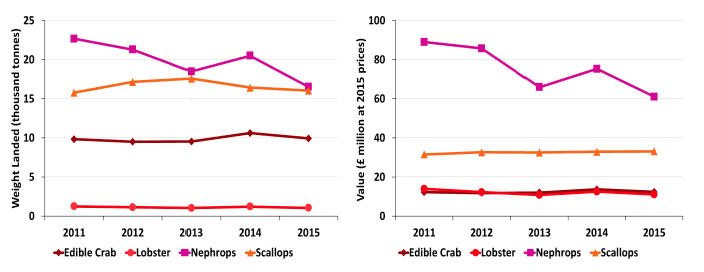
1.2 Landings abroad by Scottish registered vessels
In 2015, Scottish vessels landed 169 thousand tonnes of sea fish and shellfish abroad with a corresponding value of £107 million. The quantity of landings abroad decreased by four per cent and the value of landings abroad decreased by 16 per cent in real terms since 2014. Apart from Ireland and the Netherlands, landings abroad by Scottish vessels into EU and non- EU countries decreased both in quantity and value during 2015 ( Table 1.1.d and 1.3).
Landings abroad accounted for 38 per cent of all landings by Scottish vessels in terms of quantity and 25 per cent in terms of value. Of this, 94 per cent of the quantity of landings abroad were pelagic, six per cent were demersal and less than half of one per cent were shellfish. The main species landed abroad was mackerel, with a value of £75 million this represents 70 per cent of the total value of fish landed abroad in 2015. Since 2014, mackerel landings abroad have decreased in quantity by five per cent and decreased in value in real terms by 22 per cent. There were 112.5 thousand tonnes of mackerel landed abroad, which is 56 per cent of the total quantity of mackerel landed by Scottish vessels. The price for mackerel landed into the UK in 2015 was, on average, £635 per tonne, while mackerel landed abroad received an average of £667 per tonne.
The majority of Scottish landings abroad were made into Norway, and nearly all were pelagic species. In 2015, 91 per cent of the value of landings into Norway was for mackerel, amounting to 101.6 thousand tonnes with a value of £68 million. The key countries for demersal landings were the Netherlands and Spain. Scottish vessels landed ten thousand tonnes of demersal species abroad with a value of £15.6 million. Only 0.4 thousand tonnes of shellfish were landed abroad by Scottish vessels in 2015, mainly into Ireland and Spain.
Figure 1.1.a Quantity of landings abroad by Scottish vessels by country of landing: 2015 (tonnes)
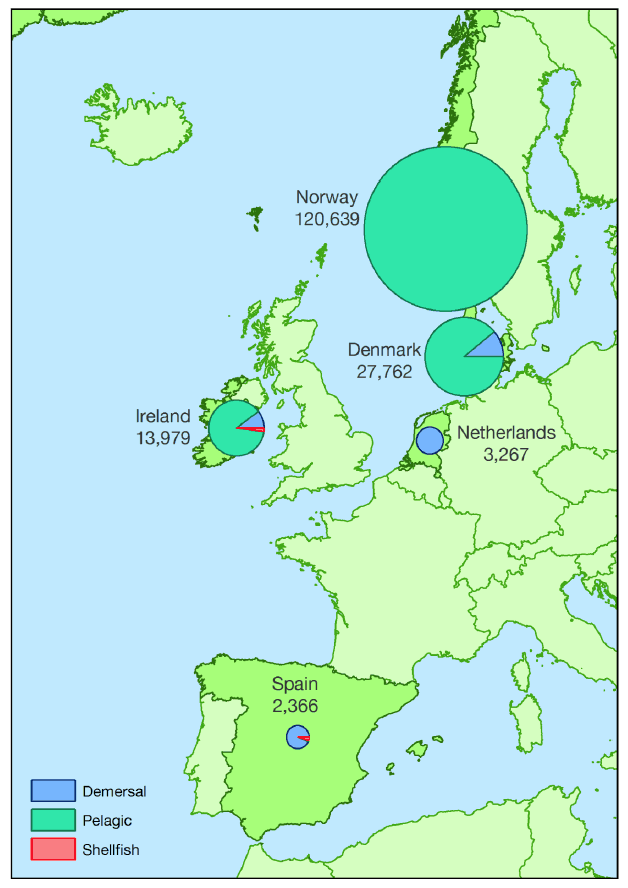
Figure 1.1.b Value of landings abroad by Scottish vessels by country of landing: 2015 (£' thousands)
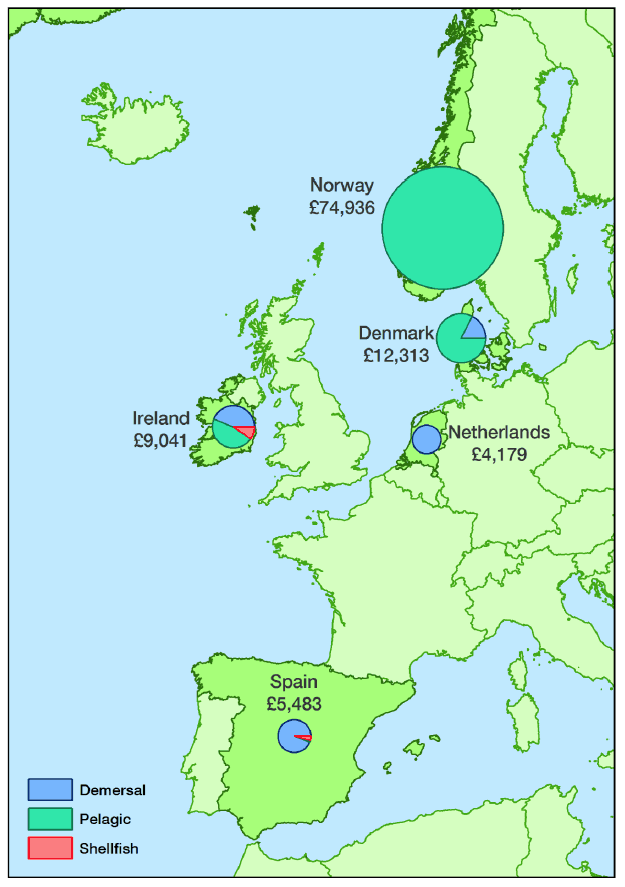
1.3 Landings by area of capture
The two main ICES areas that Scottish vessels were most active in during 2015 were the Northern North Sea ( ICES division IVa) and the West Coast of Scotland ( ICES division VIa) (Figures 1.2.a and 1.2.b). In the Northern North Sea (IVa), 232 thousand tonnes of sea fish and shellfish were caught with a value of £211 million, representing 53 per cent of the quantity and 48 per cent of the value of all landings by Scottish vessels ( Table 1.6). Just under a third (30 per cent) of landings by Scottish vessels in terms of quantity were caught in the West Coast of Scotland (VIa), providing 31 per cent of the total value of all Scottish landings.
Sixty seven per cent of the quantity of all demersal landings by Scottish vessels were caught in the Northern North Sea (IVa). Of the total quantity of pelagic landings, 55 per cent were caught in the Northern North Sea (IVa) and 33 per cent were caught in the West Coast of Scotland (VIa). More shellfish species were caught in the West Coast than in the Northern North Sea. In terms of quantity shellfish catches from the West of Scotland accounted for 36 per cent of all shellfish landings, whereas 20 per cent of shellfish landings were caught in the Northern North Sea (IVa). The Central North Sea ( ICES division IVb) and the Irish Sea (VIIa) are also areas of considerable activity for shellfish fisheries. Sixteen per cent of shellfish catches are from the Central North Sea (IVb) and 20 per cent are from the Irish Sea (VIIa). Almost all catches from the Irish Sea are of shellfish species. The rest of Area VII ( i.e. not the Irish Sea) had considerable activity from demersal, pelagic and shellfish vessels, with nine per cent of the quantity of all landings being caught in this area.
Further data of fishing activity in the seas around the UK by Scottish vessels, other UK vessels, and foreign vessels that land into the UK will be available on the ICES rectangle webpage on the Scottish Sea Fisheries Statistics website. This data shows the quantity and value of landings by species type by ICES rectangle. Further maps on fishing activity in Scottish waters by Scottish vessels, other UK vessels, and foreign vessels that land into the UK will be available on the National Marine Plan Interactive (NMPi) webpage.
Figure 1.2.a Quantity of landings by Scottish vessels by area of capture: 2015 (tonnes)
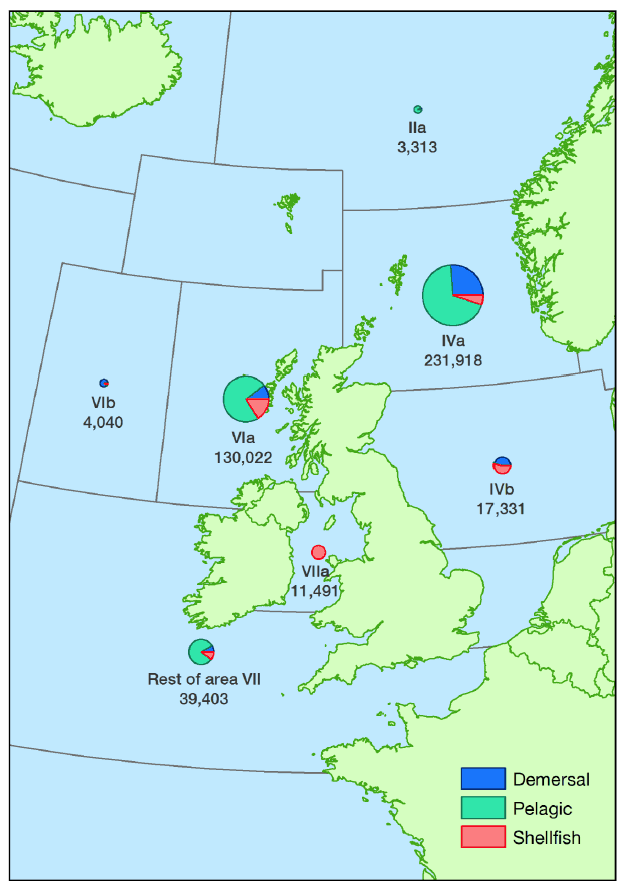
Figure 1.2.b Value of landings by Scottish vessels by area of capture: 2015 (£'thousand)
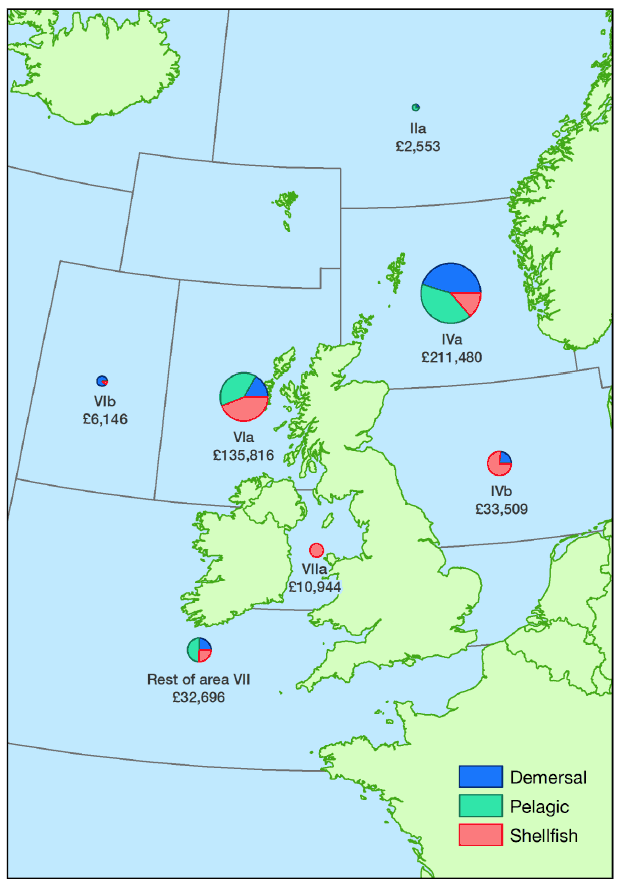
1.4 Landings into Scotland
In 2015, there was 314 thousand tonnes of sea fish and shellfish landed into Scotland with a value of £391 million. This represents a 16 per cent decrease in quantity and a 17 per cent decrease in value in real terms since 2014. Landings of demersal species accounted for 50 per cent, shellfish species 31 per cent and pelagic species 20 per cent of the total value of all landings into Scotland. However, in terms of quantity, 47 per cent of landings into Scotland were pelagic, 39 per cent were demersal and 15 per cent were shellfish species. The differences in how each species type contributed to the total value and total quantity of landings into Scotland highlights the differences between the prices per tonne across the species types. Shellfish receive relatively high prices per tonne, whilst pelagic species receive lower prices per tonne ( Table 1.1.s).
Figure 1.3.a and b and Table 1.7 show landings by all vessels by species type into the eighteen Scottish districts. Landings into the south-west coast and south-east coast were dominated by shellfish, while landings into the north-west coast constituted both demersal and, to a lesser extent, shellfish species. The three largest districts in Scotland in terms of quantity of landings were Peterhead (east coast), Shetland (north) and Fraserburgh (east coast). These districts receive landings of all three species types, although Peterhead and Shetland receive relatively small amounts of shellfish compared to demersal and pelagic species.
Combined, the top three districts accounted for 74 per cent in quantity and 54 per cent in value of all landings into Scotland. Peterhead saw 138 thousand tonnes landed in 2015, with a value of £124 million. In terms of quantity, 58 per cent of the landings into Peterhead were of pelagic species which accounted for 32 per cent of the landings value. In contrast, 40 per cent of the quantity of landings into Peterhead were of demersal species which accounted for 62 per cent of the value.
Landings into Shetland totalled 72 thousand tonnes and were valued at £61 million. As with Peterhead, the majority of landings into Shetland were of pelagic species, which represented 75 per cent of the total quantity and 51 per cent of the total value of landings. Demersal species accounted for 22 per cent of the quantity and 43 per cent of the value landed into Shetland.
In contrast, Fraserburgh was dominated by shellfish landings, accounting for 44 per cent of the value of all landings into this district. In terms of quantity, 48 per cent of landings into Fraserburgh were pelagic species and 33 per cent were demersal species. Fraserburgh experienced the biggest decrease in value of landings from 2014 with a drop of 32 per cent in the value in real terms value. This was due to a reduction in the quantity of both shellfish and pelagic landings, which decreased by 41 per cent and 30 per cent respectively.
Figure 1.3.a Quantity of landings into Scotland by all vessels by district: 2015 (tonnes)
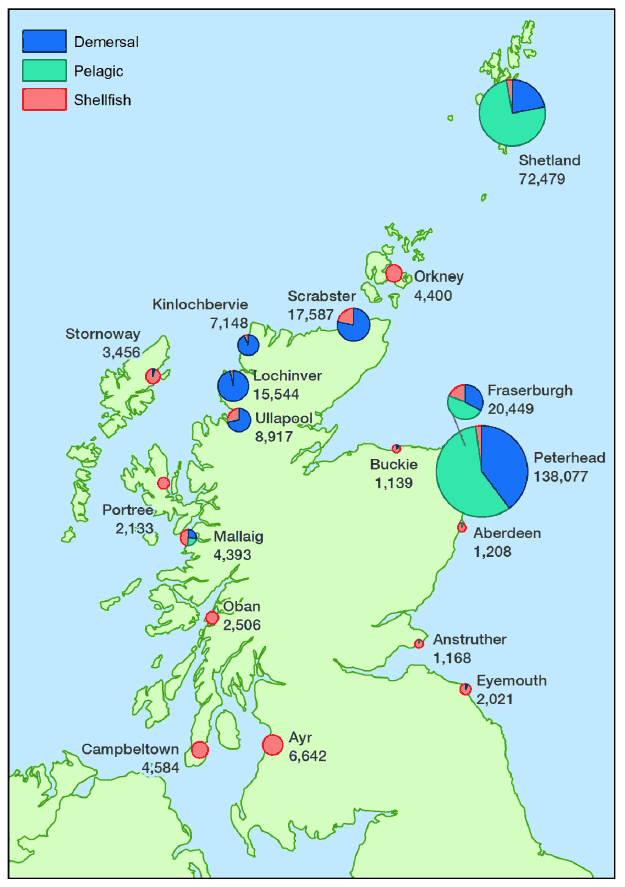
Figure 1.3.b Value of landings into Scotland by all vessels by district: 2015 (£'thousand)
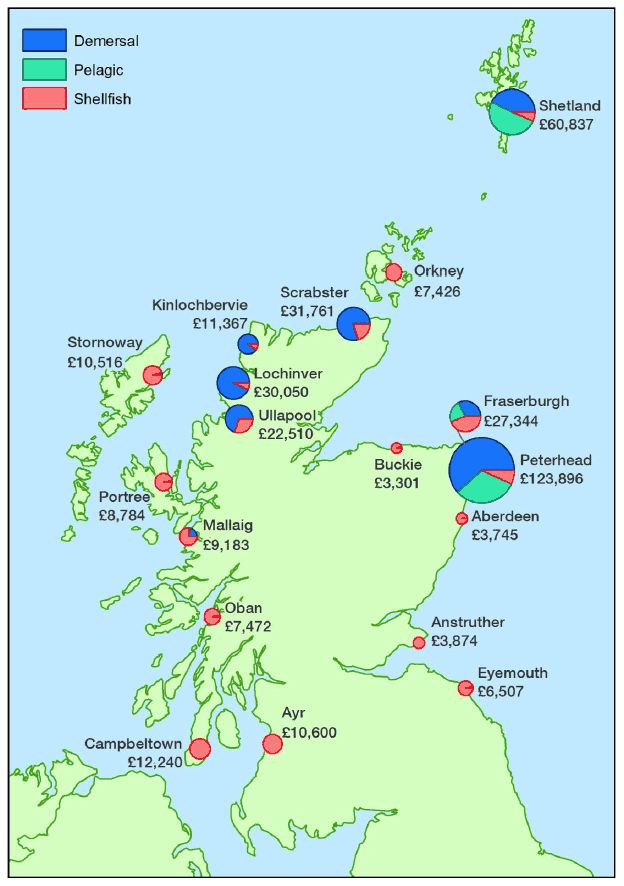
1.5 Total allowable catches quota and uptake
Table 1.10 shows the total allowable catch ( TAC) for stocks that are subject to quota. TACs are a catch limit set for individual stocks and are fixed on an annual basis at international negotiations. Some stocks are managed and fished only by European Union ( EU) member states and the TAC for these are set by the European Commission through internal negotiations between those EU member states with an interest. Other stocks are managed and shared with non- EU states and TACs for these are set at separate negotiations with interested parties, particularly Norway, Iceland, the Faroe Islands and the Russian Federation (the 'Coastal States').
The EU TAC is shared among EU member states based on a number of factors, including each member state's past catch record. This share, known as quota, is displayed in Table 1.10 at the UK and at the Scottish Producers Organisations ( POs) level. The quantity and percentage uptake of this quota is also given for each stock in Table 1.10.
Chart 1.6 compares the quota uptake of important demersal and pelagic stocks in Scottish Producer Organisations in 2015 and 2014. North Sea monkfish exceeded 100 per cent quota uptake and North Sea cod reached 100 per cent. North Sea saithe, North Sea whiting and West of Scotland monkfish all exceeded 99 per cent quota uptake, while North Sea Nephrops reached 73 per cent. At the end of 2015, North Sea haddock quota uptake was 83 per cent, 17 percentage points lower than 2014. This is due to larger haddock not being as prevalent in 2015 as they have been in previous years. In the West of Scotland, haddock and saithe quota uptake both exceeded 96 per cent, while Nephrops quota uptake exceeded 84 per cent. Quota uptake exceeded 100 per cent for North Sea herring and both West of Scotland herring and mackerel.
Chart 1.6 Quota uptakes of important stocks by vessels in Scottish POs in 2014 and 2015
Demersal stocks
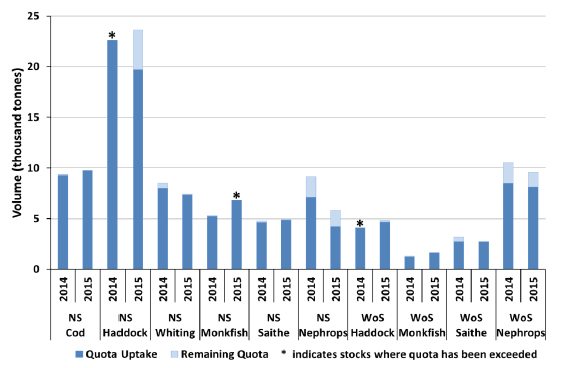
Pelagic stocks
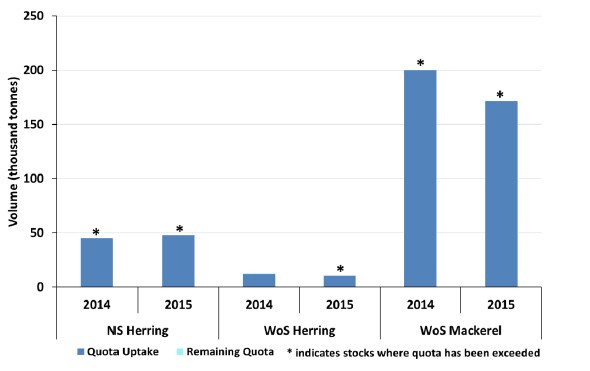
Contact
There is a problem
Thanks for your feedback